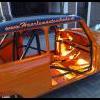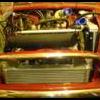
Breathing Of My Engine
#1

Posted 15 December 2011 - 02:33 PM
A while back I've bought a 1380 for my track day mini. The person who's built the engine, (he is banned from this site so I've heard), used a clutch/drop gear housing without a breather hole. I've been told that I could get into trouble when driving long/high speed left corners on the track. Now before I take apart the engine to tap drill another breather hole, is this necessary or could I do with making another breather on the rocker cover? I'm curious what ones idea is on this matter.
Jelle
#2

Posted 15 December 2011 - 04:46 PM
#3

Posted 15 December 2011 - 05:29 PM
#4

Posted 15 December 2011 - 06:12 PM
#5

Posted 15 December 2011 - 06:50 PM
you could use the filler cap as an extra breather , to save drilling a hole
some info http://www.burtonpow...her-system.html
http://www.ebay.co.u...=item256a0307da
I've seen it done on warn engines , to catch blow by oil vapour
Edited by sledgehammer, 15 December 2011 - 06:55 PM.
#6

Posted 15 December 2011 - 07:02 PM
#7

Posted 15 December 2011 - 07:05 PM
#8

Posted 15 December 2011 - 07:14 PM
#9

Posted 15 December 2011 - 07:21 PM
#10

Posted 15 December 2011 - 07:26 PM
if engine in the car , remove the clutch , jack o/s of engine up as far as drive shaft / rad / etc allows , and pop it off & drill it
If you are worried about it - do it
#11

Posted 15 December 2011 - 07:34 PM
't need to pull anything apart.
#12

Posted 15 December 2011 - 09:54 PM
#13

Posted 15 December 2011 - 10:35 PM
#14

Posted 15 December 2011 - 11:06 PM
The oil cap already has a breather, but it's small. It's where fresh air enters the system to draw the crud out. This could be enlarged but it would be better to fit a pipe to the rocker box.
but why is it a problem if tey stay there, do modern engines have this feature
All engines have some form of crankcase ventilation and from the '60s onwards there have been increasing efforts to clean up the fumes that leave the engine. Engine's are very hard to seal up completely. The piston seal into the cylinder is not perfect, there will always be some amount of blowby getting into the crankcase. Also, as the engine hears up the contents of the crankcase expands. All this means there is a higher than ideal pressure in the crankcase that the pistons have to fight against. Eventually the blowby would pressurise the crankcase to the point where the engine would slow and stop but long before that it would be working very hard and become horribly inefficient. The pressure also makes the seals work harder and fail sooner, it forces hot oil to escape from anywhere it can. The various fumes in the blowby gas include all the nastiest bits of combustion gas, and a hell of a lot of water vapour. All this breaks the oil and damages internal parts of the engine. It builds up on surfaces inside as a varnish. So all this gas has to come out. The best way to deal with it is to allow the oil vapour to cool and condense, then drain back into the engine, and burn off whatever else might be in there. So the fumes are drawn into breather cans that contain wire wool that has a lot of surface area to condense the oil, and to act as a flame trap, and from the cans the gasses travel into the inlet system to be burned. A metered amount of clean air is allowed in (through the oil cap in a Mini) to help purge the fumes through. Modern engines (and some more expensive higher performance earlier vehicles) use digital or mechanical systems to make sure this gas is only admitted into the inlet for burning when the engine is at its most efficient burn and only in small amounts. This additional burn of ungraded mixtures of flamable gasses dilutes the engine charge however and so can reduce the power produced very slightly, so in competition it's not ideal. So for race engines the breathers are either simply open to atmosphere, filtered or use a catch can. They don't burn the fumes.
#15

Posted 15 December 2011 - 11:16 PM
On a race engine you would ideally have an open breather on every individual chamber inside the engine. In the case of a Mini that means the rocker box, the tappet chest, the crank case, the transfer gear case and the timing case. The fuel pump plate will do for the crankcase, the tappet chest can only be managed really if the engine has tappet covers, the timing chest is easy with a breather timing cover (if it's been fitted with a belt conversion don't worry about it), the rocker box can easily have a pipe fitted, and the transfer gear case breather should really be opened up. Most race series won't allow an open breather, so you have to take the outlets to a catch tank where the oil vapour can condense and be collected and the tank then has a large filtered air outlet. If this is a road engine it's different and as Roy says the best thing is to burn off the crud through the inlet.
The oil cap already has a breather, but it's small. It's where fresh air enters the system to draw the crud out. This could be enlarged but it would be better to fit a pipe to the rocker box.
but why is it a problem if tey stay there, do modern engines have this feature
All engines have some form of crankcase ventilation and from the '60s onwards there have been increasing efforts to clean up the fumes that leave the engine. Engine's are very hard to seal up completely. The piston seal into the cylinder is not perfect, there will always be some amount of blowby getting into the crankcase. Also, as the engine hears up the contents of the crankcase expands. All this means there is a higher than ideal pressure in the crankcase that the pistons have to fight against. Eventually the blowby would pressurise the crankcase to the point where the engine would slow and stop but long before that it would be working very hard and become horribly inefficient. The pressure also makes the seals work harder and fail sooner, it forces hot oil to escape from anywhere it can. The various fumes in the blowby gas include all the nastiest bits of combustion gas, and a hell of a lot of water vapour. All this breaks the oil and damages internal parts of the engine. It builds up on surfaces inside as a varnish. So all this gas has to come out. The best way to deal with it is to allow the oil vapour to cool and condense, then drain back into the engine, and burn off whatever else might be in there. So the fumes are drawn into breather cans that contain wire wool that has a lot of surface area to condense the oil, and to act as a flame trap, and from the cans the gasses travel into the inlet system to be burned. A metered amount of clean air is allowed in (through the oil cap in a Mini) to help purge the fumes through. Modern engines (and some more expensive higher performance earlier vehicles) use digital or mechanical systems to make sure this gas is only admitted into the inlet for burning when the engine is at its most efficient burn and only in small amounts. This additional burn of ungraded mixtures of flamable gasses dilutes the engine charge however and so can reduce the power produced very slightly, so in competition it's not ideal. So for race engines the breathers are either simply open to atmosphere, filtered or use a catch can. They don't burn the fumes.
I've already bought the catch tank with filter. I'm not running a full spec race engine, (1380, 285 cam, stage 4 CH, weber DCOE 45 on a maniflow steel inlet and weber box, UL clutch, maniflow stage 2 manifold, 123 ignition) but I'm looking on some track time revving it up to 7500 rpm. So to sum things up, I'll just have to drill the hole in the gear transfer case and idealy add a breather to my rocker cover and blanking plate. The only original I have now is on the timing chain cover. Back to the drawing board I quess. In the end better than blowing up the engine.
Thanks!
Edited by Jellevandok, 15 December 2011 - 11:17 PM.
1 user(s) are reading this topic
0 members, 1 guests, 0 anonymous users


















